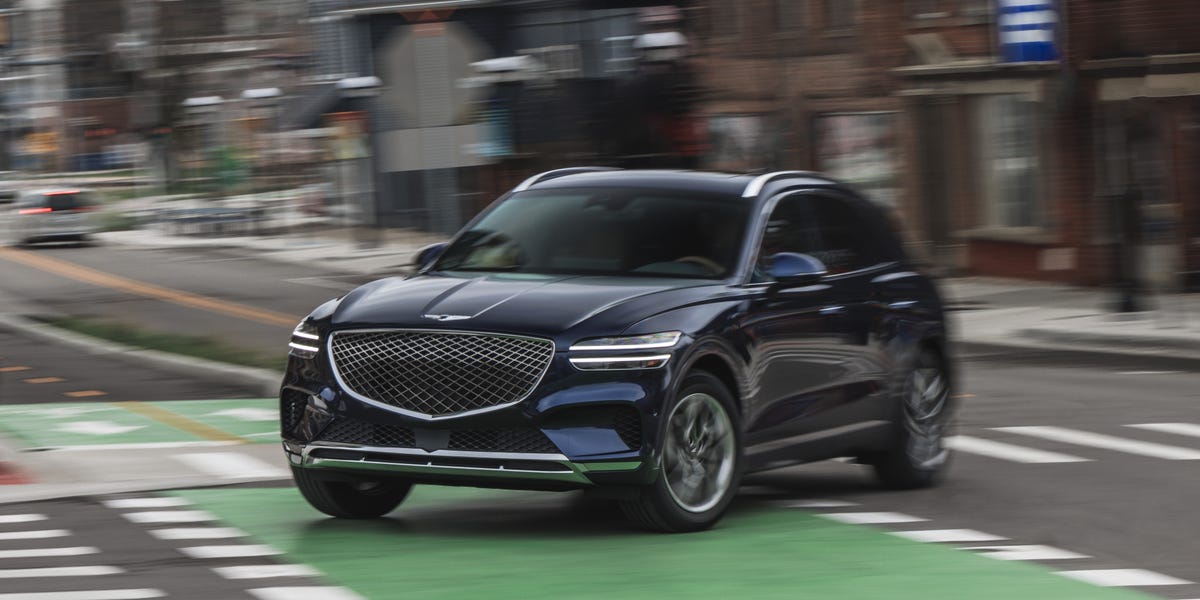Tested: 2022 Genesis GV70 2.5T Follows Close behind the 3.5T

We’ve been mighty impressed with the Genesis GV70. The compact SUV just vanquished the BMW X3 and the Lexus RX in a comparison test, and we’ve welcomed a GV70 for a long-term test to see how it stacks up over 40,000 miles. Both of those examples, as well as the one we drove for our initial review, are the six-cylinder 3.5T model. But what about the four-cylinder variant? Turns out, the entry-level GV70 gives up little to its more powerful sibling.
The 2.5T employs a turbocharged 2.5-liter four that also serves in other Genesis models, as well as the Hyundai Sonata N Line, Kia K5 GT, and Kia Sorento. Here, it makes 300 horsepower and 311 pound-feet of torque, the latter over a broad rev range of 1650 to 4000 rpm. That’s a good bit less than the 375 horses and 391 pound-feet from the 3.5T’s twin-turbo V-6, but it’s a strong showing for a turbo four. As in the GV70 3.5T, an eight-speed automatic handles the shifting duties, and all-wheel drive is standard. However, the six-cylinder’s available limited-slip rear differential can’t be had here.
Michael SimariCar and Driver
The turbo four’s 75-pony deficit relative to the twin-turbo V-6 adds 1.0 second to its 60-mph sprint, with the 2.5T completing the dash in 5.6 seconds. That puts it neck and neck with the Audi Q5 45 (5.5 seconds) yet well ahead of both the Volvo XC60 B6 (6.6 seconds) and the BMW X3 30i (6.1 seconds). It also hustles through the quarter-mile in 14.1 seconds at 99 mph, against 13.3 and 104 mph for the six-cylinder version.
Away from the test track, we found the base powertrain to have plenty of urge. It’s mostly well polished in its response, with only the faintest surging in light throttle applications over rolling terrain. The eight-speed automatic generally impresses with its invisibility and is a better teammate to this turbo four than is the eight-speed dual-clutch gearbox that Hyundai and Kia pair with this engine.
Michael SimariCar and Driver
HIGHS: Quiet cruising, artful interior, still enjoyably quick.
Like the twin-turbo V-6, the turbocharged four-cylinder can deliver its electronically enhanced engine sound in a choice of three volume levels—but that sound is not as endearing as the six’s. Choose the quietest, and the GV70 2.5T is hushed indeed. We measured a mere 65 decibels at a 70-mph cruise—significantly quieter than its G70 sedan sibling—and 73 decibels at wide-open throttle. Both those results are quieter than the 3.5T’s, and that cruising noise level even beats six-figure big rigs such as the Cadillac Escalade, Lincoln Navigator, and Lexus LX600.
Stops from 70 mph take a somewhat long 177 feet. Although that’s better than the 180-foot result we got in initial testing of our long-term 3.5T, it’s not as good as the X3’s 175 feet or the XC60’s 164 feet. Both GV70 models allow the driver to adjust brake-pedal response, but we had a hard time discerning much of a difference between each car’s two settings.
Michael SimariCar and Driver
As you’d expect, EPA fuel economy for the four-cylinder GV70 is better than with the 3.5T. EPA estimates of 22 mpg city/28 highway match or are within 1 mpg of the figures for the X3 xDrive, XC60, Q5, and Infiniti QX50. Opting for the 21-inch wheels, however, drags down the city figure by a whopping 3 mpg and the highway number by 2 mpg, putting it almost on par with the V-6 version. Our Advanced-trim-level test car was fitted with 19s, and in our 75-mph highway fuel-economy test we exactly matched the EPA’s 28 mpg. That’s a significant 5 mpg better than we saw in the same test with the 3.5T.
Like the 3.5T, the 2.5T has Eco, Comfort, Sport, Sport+, and Custom drive modes. Here, they don’t affect the suspension (adaptive dampers are exclusive to the V-6) but do somewhat alter the character of the steering, transmission, engine sound, and brakes. The extensive adjustability is of limited value. The Sport mode’s heavier steering really isn’t preferable with the standard setup. And that setting’s shift mapping is good if you’re going to attack a spate of twisties, but its reluctance to upshift when just cruising will prevent most drivers from leaving the car in that mode.
Michael SimariCar and Driver
LOWS: Missing some fancier features, not the best at carrying bulky cargo.
Although the 2.5T is missing the 3.5T’s adaptive suspension, we found the standard setup to be agreeable overall. It does an impressive job of sopping up broken pavement, which is plentiful in spring in the Northeast. It doesn’t have quite the stiffness of the 3.5T’s Sport mode but still feels more composed than most entries in this segment. On the skidpad, we measured 0.82 g of stick, exactly matching the 3.5T. And if you’re looking to un-stick the rear end, the stability control can be fully deactivated.
Whereas the six-cylinder models we’ve driven previously were the top-spec Sport Prestige version, our mid-level 2.5T Advanced test car was still nicely turned out. Even in this lesser trim, the GV70’s interior is one of the more interesting cabin designs with its ovoid shapes and extensive brushed-metal detailing. The pattern of the upholstery stitching isn’t the snazzy quilting found in the 3.5T, but there are still flourishes about, such as vents integrated into the dash trim and the wave-pattern ambient lighting on the door panels (exclusive to the Advanced model).
Michael SimariCar and Driver
The GV70’s seats have lots of adjustability, and these are more softly padded than the chairs in the 3.5T Sport Prestige. Under-thigh extensions and lateral bolsters that squeeze tighter in Sport+ mode are optional here. Like your mother, the GV70 also is concerned about your posture. After asking you to input your height, inseam, and weight (no fibbing), the Ergo Motion driver’s seat will automatically adjust for your ideal posture—although in our case, the suggested position was a wildly reclined Detroit lean, which didn’t seem quite right. When it comes time for carrying cargo, the GV70 sacrifices some practicality for the sake of style. Although its 29 cubic feet of cargo space behind the rear seats is on par with competitors such as the X3, the fast-falling roofline and rounded rear profile restrict the ability to accommodate bulky items.
The 2.5T models skip the 3-D digital instrument cluster found in the 3.5T Sport Prestige. Instead, they have a physical speedometer and fuel gauge combined with a digital reverse-sweeping tach and info display. The latter can show a digital speed readout, trip info, torque flow, and driver-assist features, among other items. In the top two trims, the camera feed from the blind-spot monitor replaces the virtual tach when the turn signal is activated.
Michael SimariCar and Driver
All GV70s have a large, 14.5-inch center touchscreen. The wide-screen infotainment display is asymmetrically divided and getting what you want to appear in the smaller part of the display can be tricky. One mild irritation is that at startup, the system defaults to the rather pointless home screen that shows a clock and nothing else. The surround-view monitor—which simultaneously shows overhead and backup views—is one of the sharpest we’ve seen and is included in the top two trims. We like having a large rotary controller on the center console, but we don’t love the fact that the rotary shift dial is so similar in size and placement. And the thumbwheels for volume and tuning are fussier than knobs would be.
The 2.5T’s top two trims also include automated parking, plus the neat party trick of allowing you to stand outside the car and use the remote to guide the GV70 straight into or out of a tight spot. The digital-key feature is exclusive to the 3.5T, however.
Although some fancier items are missing from the 2.5T, it’s still well equipped—particularly for the price. The four-cylinder GV70 starts at $42,595, and the Advanced version costs $50,745 before options. Depending on trim level, the 2.5T is a substantial $8250 to $11,600 cheaper than the 3.5T. While it may be the lesser GV70, it really doesn’t feel that inferior.
A car-lover’s community for ultimate access & unrivaled experiences. JOIN NOW
This content is created and maintained by a third party, and imported onto this page to help users provide their email addresses. You may be able to find more information about this and similar content at piano.io



